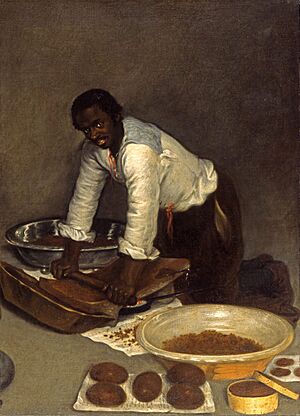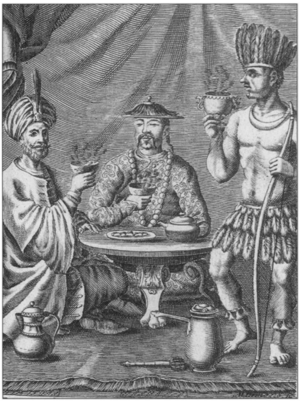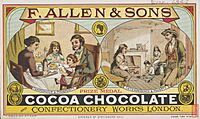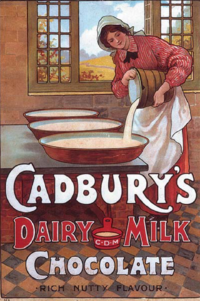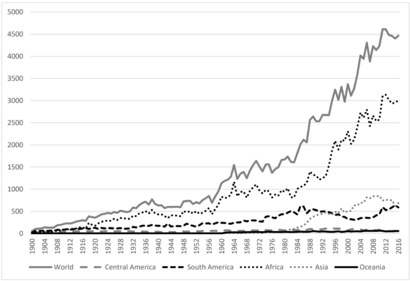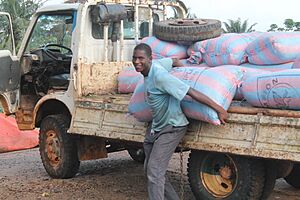History of chocolate facts for kids

The history of chocolate is a fascinating journey that spans over 5,000 years! It all began when the cacao tree was first grown by people in what is now Mexico. Soon, this special tree was brought to Mesoamerica (parts of Central America and Mexico). Here, cacao drinks became very important for cultures like the Maya and the Aztecs.
Ancient people thought cacao was a gift from the gods. They used it as money, as medicine, and in important ceremonies. Many different cacao drinks were made. Some early evidence shows people enjoyed cacao drinks as far back as 600 BC. They believed it had unique powers.
Spanish explorers first found cacao in 1519. They brought it to Spain, where it was first used as a medicine. From Spain, chocolate spread across Europe over the next 300 years. It became very popular among wealthy people. In the 1800s, new inventions changed chocolate forever. It went from being a fancy drink to a solid treat that everyone could enjoy. This time saw the rise of famous Swiss and British chocolate makers. Production also became much faster thanks to new factories.
Since the early 1900s, chocolate has kept changing. New types like white chocolate were created. Companies also started adding ingredients like different fats. Chocolate production grew a lot in the 20th century, reaching new places like Asia and Africa. People also became more aware of how cacao farmers were treated. This led to efforts to ensure fair working conditions. Today, the global chocolate business is worth over US$100 billion!
Contents
What's in a Name? The Word "Chocolate"
The word "chocolate" comes from Spanish. It was first written down in Spanish in 1579 and in English in 1604. Where it truly comes from is a bit of a mystery!
Many people think it comes from the Nahuatl language, spoken by the Aztecs. They used words like cacahuatl (meaning "cacao water") for their cacao drinks. Some experts think it might come from a Nahuatl word meaning "bitter drink."
Another idea is that it comes from a Mayan language word. This word might have meant "hot water." Some also suggest it could be from a word meaning "cacao-beater," referring to how they whisked cacao to make foam. It's cool to think about how words travel and change over time!
Chocolate's Ancient Roots
Cacao's First Home in South America
The cacao tree originally grew in the Amazon rainforest. People first started growing cacao around 3300 BC in what is now Ecuador. This was long before it reached Mesoamerica. Scientists found clues in old pottery, like tiny cacao bits and special compounds. These clues showed that ancient cultures, like the Mayo-Chinchipe, were using cacao. They even made a fermented drink from the sweet pulp around the seeds.
Cacao in Ancient Mesoamerica
Cacao was very important in Mesoamerica. People there learned to grow many types of cacao trees. The earliest signs of cacao drinks in this area are from 1900 BC. The Mokayan people in Chiapas, Mexico, enjoyed cacao drinks at this time.
Archaeologists found cacao traces in bowls and jars from 1800 to 1000 BC in Puerto Escondido, Mexico. The fancy designs on these pots suggest cacao was a big part of social events for important people. The Olmecs, another ancient culture, also drank cacao. They might have used it for large gatherings and special ceremonies.
The Maya and Their "Food of the Gods"
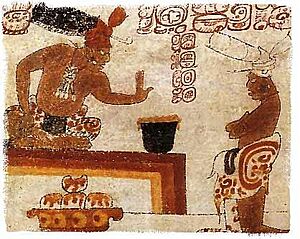
The ancient Maya were enjoying chocolate by 600 BC. They used chocolate in many important ways. It was part of official ceremonies, religious events, feasts, weddings, and festivals. They also offered it at funerals and used it as medicine.
Cacao beans and the tools for making chocolate were valuable gifts. We don't know if everyday people drank chocolate. But we do know that cacao beans were used as money as early as 400 BC! Wealthy gardeners even tried to grow cacao in Yucatán, even though it was hard. Most cacao, however, was brought in from other areas.
How the Maya Made Chocolate
To make chocolate, the Maya first fermented, dried, and roasted cacao beans. Then, they removed the outer husks. They ground the inner parts (called nibs) into a paste using special stones called manos and metates. This grinding often happened over a fire.
The paste was then shaped into solid blocks. When needed, these blocks were broken up and mixed with water and other ingredients. When heated, a fat called cocoa butter would rise to the top. The Maya would skim this off. This basic way of making chocolate stayed the same for hundreds of years!
Flavors and Froth
The Maya added flavors like vanilla to their cacao paste. Before serving, they would pour the chocolate from one pot to another from a height. This created a lovely brown foam on top, which was very popular. They judged the quality of the drink by its foam, color, and smell.
Cacao was seen as a gift from the gods. The Maya even had a god, Ek Chuah, who was linked to cacao. Later, the Maya introduced chocolate to the Aztecs.
The Aztecs and Their Special Drink
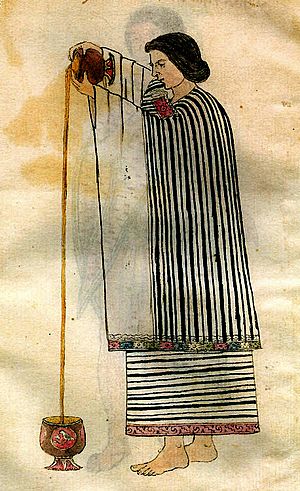
Chocolate was one of the most important drinks for the Aztecs. It was a luxury, enjoyed by the wealthy and powerful. The Aztecs believed cacao was a gift from their god Quetzalcōātl. They used cacao beans as a symbol in important rituals. Sometimes, they added a food coloring called annatto to make the drink red.
The Aztecs used chocolate as gifts for their rulers and offerings to their gods. Only the Aztec leaders, nobles, and important traders usually drank chocolate. It was served at fancy banquets. Soldiers were an exception; they received chocolate as a stimulant to help them in battle. They ate it as small pellets or wafers.
Cacao as Currency and Medicine
Cacao trees could not grow in the main Aztec lands because of the cold. So, most cacao beans were brought from a region called Soconusco, which the Aztecs had conquered. The people there had to pay tribute in cacao beans. At the time of the Spanish arrival, 1.5 million cacao trees grew in Soconusco. Traders carried huge amounts of beans across the Aztec lands.
Cacao beans were so valuable that they were used as money. In 1545, you could buy a small rabbit for thirty beans! One bean could get you a large tomato. Sometimes, people even tried to fake cacao beans using other materials.
Aztec Chocolate Flavors
While chocolate was mostly a drink, it was sometimes eaten. It could be served hot or cold. The Aztecs often added dried and ground chili to their chocolate. Other ingredients like honey, vanilla, or flowers were also used. Women were usually the ones who prepared the cacao drinks.
Chocolate Arrives in Europe
European Explorers Discover Cacao
On his fourth voyage in 1502, Christopher Columbus saw a Mayan trading canoe. His crew noticed how much the canoe's occupants valued cacao beans. But they didn't know what they were or that they could make a drink from them. Later, in 1520, Spanish explorer Hernán Cortés might have been the first European to see chocolate being prepared in the court of the Aztec ruler, Moctezuma II.
By 1524, the Spanish controlled central Mexico. They increased cacao production, often using forced labor. Many Native Americans suffered a huge population decline during the 16th century. This led to less cacao being produced. So, more cacao was grown in Ecuador and Venezuela, often using enslaved people from Africa. The cacao from these new areas was a different type, called Forastero. It was more bitter than the Criollo type grown in Mesoamerica.
Chocolate Adapts to Spanish Tastes
At first, many Spaniards in the Americas didn't like chocolate. They especially disliked the foam. Spanish men often learned about chocolate from the Aztec women they married or lived with. As more Spanish women arrived, Aztec women continued to work in homes as servants. They helped teach others how to make chocolate.
To make chocolate taste better for them, the Spanish added sugar and familiar spices. They also served it warm. Instead of pouring it from a height, they used a wooden whisk called a molinillo to create foam. Nuns in early colonial times even made and sold solid sweet chocolates as treats, which were very popular.
Spreading Across Europe
The exact date chocolate arrived in Spain is unknown. However, in 1544, Mayan nobles brought to Spain by friars introduced it to the Spanish court. By the 16th century, the Spanish were very interested in the medicinal uses of plants from Mesoamerica. They thought chocolate could help with various conditions. By the mid-1500s, chocolate was being made and sold in large amounts.
From Spain, chocolate spread to other European countries like Portugal and Italy in the 1600s. Religious groups helped share it. Drinking chocolate became very popular among Europe's wealthy people. It was expensive because of high shipping costs and taxes. For a long time, people debated if chocolate counted as food or just a drink. This was important for religious fasting rules.
Chocolate arrived in France, likely as a medicine, and then in England around 1657. It came at the same time as tea and coffee. British plantations in Jamaica supplied cocoa after the British took over the island in 1655. In England, chocolate became a commercial product, sold in coffee houses. By the late 1600s, it was even part of the British Navy's rations. From England, chocolate reached the North American colonies by the late 1600s.
A Treat for the Elite
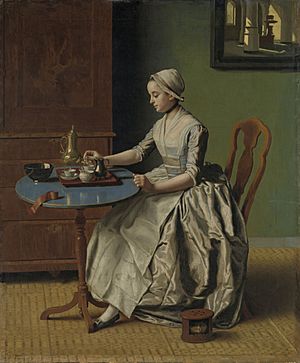
In the 1700s, chocolate was seen as a fancy, aristocratic treat in southern Europe. This was different from coffee, which was for the middle class, and alcohol, which was for working people. Even though the way chocolate was made was still similar to ancient methods, people also ate it as bars, candies, and in desserts. In 1753, a Swedish scientist named Carl Linnaeus gave cacao its scientific name: Theobroma, meaning "food of the gods."
In Spain, chocolate was popular for breakfast and after dinner. Chocolate grinding guilds formed in cities. In Italy, chocolate was often used in savory dishes. In France, it was mainly used in desserts. New machines were invented to help make chocolate. In 1729, Walter Churchman in Britain got a patent for a water-powered cocoa mill. In the American colonies, water-powered milling started in 1765.
Chocolate for Everyone: The Modern Era
Chocolate Becomes Popular
In 1828, Coenraad Johannes van Houten invented a way to make Dutch cocoa. This process removed much of the cocoa butter from the chocolate liquid, creating a powder. This invention made it possible to produce chocolate cheaply and in large amounts, both as powder and solid bars. This opened the door for chocolate to become a treat for everyone.
Many Quaker families, who believed chocolate was a good alternative to alcohol, started famous chocolate companies during the Industrial Revolution. These included J. S. Fry & Sons, Cadbury, and Rowntree's. In 1847, Fry's created a method to mix cocoa butter with cocoa powder and sugar. This made the first solid chocolate bar that wasn't brittle. This led to the creation of the chocolate box and the chocolate Easter egg.
Swiss Innovations and Global Growth
In 1819, François-Louis Cailler opened the first chocolate factory in Switzerland. In the 1860s, Van Houten's Cocoa improved cocoa powder's taste and color. Modern milk chocolate was invented in 1875 by Swiss maker Daniel Peter. He combined newly invented powdered milk with chocolate. It became very popular after 1900.
In 1879, Swiss chocolatier Rodolphe Lindt invented the conching process. This involves heating and stirring liquid chocolate for days. It makes chocolate much smoother and improves its flavor. Before conching, chocolate was often gritty. This invention allowed chocolate to be used more easily in baking.
In the early 1800s, the Portuguese started growing cacao in West Africa. They brought the crop to São Tomé and Príncipe from Brazil in 1824. This led to widespread cacao farming across Africa. Sadly, this also recreated a system where people were forced to work without pay. São Tomé and Príncipe became the largest producer in 1905.
The price of chocolate dropped a lot in the late 1800s and early 1900s. This was because more chocolate was being produced in Africa and Asia. Between 1880 and 1914, the market for chocolate grew hugely in Western countries. Eating chocolate soon became more popular than drinking it.
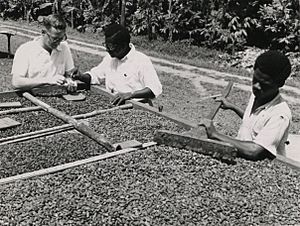
After journalists highlighted unfair labor practices in the Portuguese cacao industry, Cadbury investigated. A 1908 report described the system as "de facto slavery," meaning it was like slavery in practice. In 1909, several chocolate companies boycotted these plantations. This helped improve working conditions. Cadbury then started getting cacao from the British colony of the Gold Coast (now Ghana). Ghana became the largest cacao producer in 1911.
Chocolate After World War I
Couverture chocolate was invented in 1925 by Belgian chocolatier Octaaf Callebaut. Tempering, a process of carefully cooling and heating chocolate for a crisp break and shiny look, was developed by 1931. In 1936, Nestlé first sold white chocolate. After World War II, lecithin was added to chocolate to make it smoother.
In 1956, chocolate with cheaper fats replacing some cocoa butter was introduced in Britain. There were debates about how much cocoa butter could be replaced while still calling it chocolate. By 1997, EU rules said only 5% of the fat could be substitutes. The US did not allow any substitutions.
Throughout the 20th century, cacao farms faced problems like disease and climate change. Scientists tried to create stronger cacao varieties. The way cacao was transported became more efficient with motor vehicles and shipping containers. Indonesia increased its production in the 1980s. From the late 1980s to 2019, cacao bean production doubled. New markets for chocolate grew in China and India, where chocolate often became a popular gift.
After Cadbury merged with Fry's in 1919, they competed with Swiss chocolatiers and American companies like Mars and The Hershey Company. Godiva brought Belgian-style chocolate to America in 1966, creating a big demand for high-quality chocolate. Single-origin chocolates, which come from a specific region or farm, first appeared in 1984. This started the "bean-to-bar" movement.
Chocolate Today

As of 2006, traditional cacao drinks were still made across Mesoamerica, like bupu and tejate in Oaxaca. In many rural areas, sweetened chocolate disks were sold in local markets as of 2017. In the 2000s, chocolate consumption grew in Africa. For example, in Nigeria, the market grew by 775% between 2006 and 2013.
Dark chocolate became very popular by 2009. This was due to claims about its health benefits. Raw and organic chocolates also grew in popularity by 2018. The "bean-to-bar" movement, where makers control the whole process from bean to finished bar, also expanded. By 2013, there were at least 37 such producers in the United States.
Concerns about unfair working conditions, including child labor, among African cacao growers gained public attention in the early 2000s. In 2005, an agreement called the Harkin–Engel Protocol was created by US Congress members. It aimed to address child and forced labor in the chocolate industry. This awareness led to a demand for fair trade chocolate, which helps ensure farmers are paid fairly and work in good conditions.
As of 2019, the cacao industry faced threats from diseases. Up to 38% of cacao harvested each year was lost to disease by 2017. The industry's future is also challenged by the need for more land, poor soil care, ongoing poverty for farmers, and climate change. By 2022, Ghana and the Ivory Coast supplied 57% of the world's cocoa.
In 2023, a few large companies controlled 40% of the international cacao trade. As of 2018, five major chocolate makers—Mars, Mondelez (which owns Cadbury), Ferrero, Nestlé, and Hershey—made up almost two-thirds of the global chocolate market. The international chocolate trade was worth US$108 billion in 2018. The biggest markets and highest consumption per person remained in Western countries.
Images for kids
-
Painting by Juan de Zurbarán, depicting the usual way of serving chocolate – from a cup or a bowl, c.1640.
See also
 In Spanish: Historia del chocolate para niños
In Spanish: Historia del chocolate para niños


